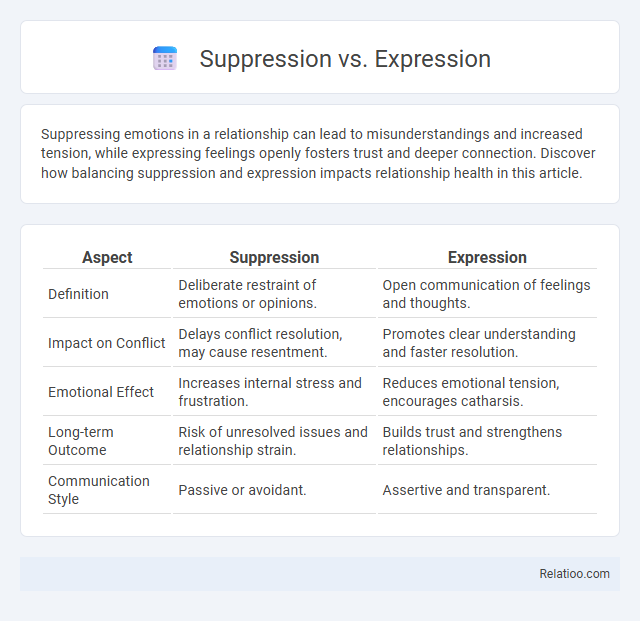Suppressing emotions in a relationship can lead to misunderstandings and increased tension, while expressing feelings openly fosters trust and deeper connection. Discover how balancing suppression and expression impacts relationship health in this article.
Table of Comparison
| Aspect | Suppression | Expression |
|---|---|---|
| Definition | Deliberate restraint of emotions or opinions. | Open communication of feelings and thoughts. |
| Impact on Conflict | Delays conflict resolution, may cause resentment. | Promotes clear understanding and faster resolution. |
| Emotional Effect | Increases internal stress and frustration. | Reduces emotional tension, encourages catharsis. |
| Long-term Outcome | Risk of unresolved issues and relationship strain. | Builds trust and strengthens relationships. |
| Communication Style | Passive or avoidant. | Assertive and transparent. |
Understanding Suppression and Expression
Suppression involves consciously inhibiting or pushing away emotions, which can lead to increased stress and negative psychological outcomes over time. Expression, on the other hand, allows individuals to communicate and process emotions effectively, fostering emotional clarity and mental health resilience. Recognizing the differences between suppression and expression is essential for improving emotional regulation and promoting overall well-being.
The Psychology Behind Suppression
Suppression involves consciously pushing away unwanted thoughts and emotions, often leading to increased psychological stress and diminished emotional regulation over time. The psychology behind suppression reveals that while it may offer temporary relief, persistent avoidance can exacerbate anxiety, depression, and hinder emotional processing. Understanding how suppression contrasts with expression and escapism empowers you to choose healthier strategies for managing your mental well-being.
What Does Expression Really Mean?
Expression refers to the authentic communication of one's thoughts, emotions, and identity through words, art, or behavior, serving as a vital outlet for mental and emotional well-being. Unlike suppression, which involves consciously or unconsciously holding back feelings, expression allows for the externalization and processing of internal experiences. Escapism, by contrast, seeks distraction or relief from reality, whereas genuine expression fosters self-awareness and emotional clarity.
Causes and Triggers of Emotional Suppression
Emotional suppression often stems from traumatic experiences, social conditioning, and fear of judgment, where individuals learn to inhibit feelings to avoid perceived negative consequences. Triggers include high-stress environments, interpersonal conflicts, and situations that evoke vulnerability, prompting a conscious or unconscious decision to mask true emotions. This coping mechanism can lead to increased psychological strain by preventing healthy emotional expression and processing.
The Benefits of Healthy Emotional Expression
Healthy emotional expression enhances mental well-being by preventing the buildup of stress and anxiety associated with suppression. Expressing your feelings authentically fosters stronger interpersonal connections and promotes emotional resilience. Avoiding escapism allows you to confront challenges directly, leading to personal growth and balanced emotional health.
Consequences of Suppressing Emotions
Suppressing emotions can lead to increased stress, anxiety, and even physical health problems such as hypertension and weakened immune response. When you bottle up feelings instead of expression or healthy escapism, unresolved emotional buildup may cause chronic mood disorders or hinder your social relationships. Understanding the negative consequences of emotional suppression is crucial for maintaining mental well-being and fostering authentic connections.
Expression Techniques for Personal Growth
Expression techniques, such as journaling, creative arts, and mindful communication, empower your personal growth by transforming suppressed emotions into constructive insights. These methods facilitate self-awareness and emotional release, enabling healthier coping strategies compared to escapism or suppression. Incorporating consistent expression practices promotes mental resilience and fosters deeper connections with your inner self and others.
Suppression vs Expression: Key Differences
Suppression involves consciously inhibiting emotions or thoughts, often leading to increased psychological stress and decreased emotional well-being, while expression allows individuals to release feelings openly, promoting mental health and authentic self-awareness. Key differences include the internalization of feelings in suppression versus externalization in expression, impacting coping mechanisms and interpersonal relationships. Research shows that emotional expression is linked to lower cortisol levels and improved immune function, whereas suppression correlates with heightened anxiety and depressive symptoms.
Finding Balance: Integrating Suppression and Expression
Finding balance between suppression and expression involves recognizing when to hold back emotions constructively and when to openly communicate them to maintain mental health. You can cultivate emotional regulation by consciously choosing moments to suppress harmful impulses while expressing authentic feelings in supportive environments. Integrating these approaches reduces stress and promotes psychological resilience, preventing the extremes of emotional overload or unhealthy escapism.
Practical Tips for Managing Emotions
Recognizing the differences between suppression, expression, and escapism is essential for effective emotional management. You can practice mindfulness techniques to acknowledge emotions without judgment, allowing healthy expression through journaling or talking with a trusted person. Incorporate grounding exercises and limit avoidance behaviors to prevent escapism, promoting emotional resilience and balance.

Infographic: Suppression vs Expression
 relatioo.com
relatioo.com